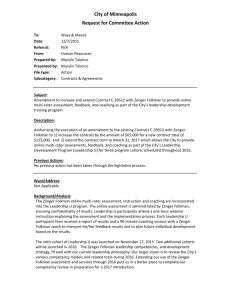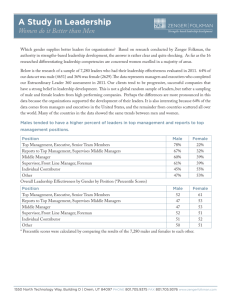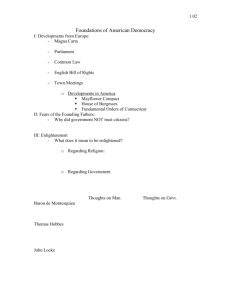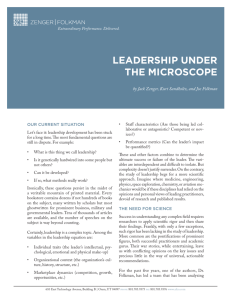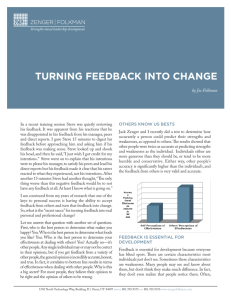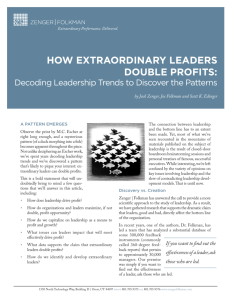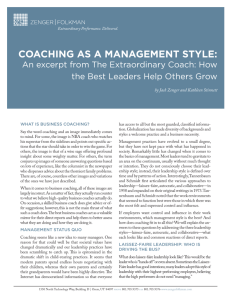Microsoft Word - MinnRFPFinal.doc
advertisement
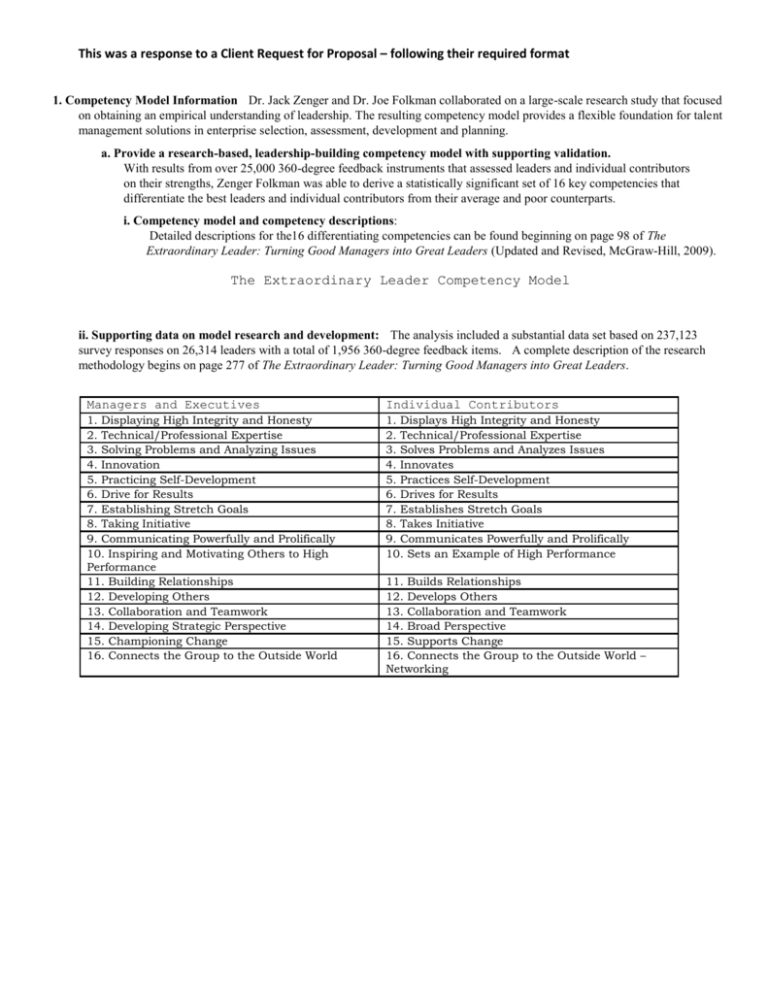
This was a response to a Client Request for Proposal – following their required format 1. Competency Model Information Dr. Jack Zenger and Dr. Joe Folkman collaborated on a large-scale research study that focused on obtaining an empirical understanding of leadership. The resulting competency model provides a flexible foundation for talent management solutions in enterprise selection, assessment, development and planning. a. Provide a research-based, leadership-building competency model with supporting validation. With results from over 25,000 360-degree feedback instruments that assessed leaders and individual contributors on their strengths, Zenger Folkman was able to derive a statistically significant set of 16 key competencies that differentiate the best leaders and individual contributors from their average and poor counterparts. i. Competency model and competency descriptions: Detailed descriptions for the16 differentiating competencies can be found beginning on page 98 of The Extraordinary Leader: Turning Good Managers into Great Leaders (Updated and Revised, McGraw-Hill, 2009). The Extraordinary Leader Competency Model ii. Supporting data on model research and development: The analysis included a substantial data set based on 237,123 survey responses on 26,314 leaders with a total of 1,956 360-degree feedback items. A complete description of the research methodology begins on page 277 of The Extraordinary Leader: Turning Good Managers into Great Leaders. Managers and Executives Individual Contributors 1. Displaying High Integrity and Honesty 2. Technical/Professional Expertise 3. Solving Problems and Analyzing Issues 4. Innovation 5. Practicing Self-Development 6. Drive for Results 7. Establishing Stretch Goals 8. Taking Initiative 9. Communicating Powerfully and Prolifically 10. Inspiring and Motivating Others to High Performance 11. Building Relationships 12. Developing Others 13. Collaboration and Teamwork 14. Developing Strategic Perspective 15. Championing Change 16. Connects the Group to the Outside World 1. Displays High Integrity and Honesty 2. Technical/Professional Expertise 3. Solves Problems and Analyzes Issues 4. Innovates 5. Practices Self-Development 6. Drives for Results 7. Establishes Stretch Goals 8. Takes Initiative 9. Communicates Powerfully and Prolifically 10. Sets an Example of High Performance 11. Builds Relationships 12. Develops Others 13. Collaboration and Teamwork 14. Broad Perspective 15. Supports Change 16. Connects the Group to the Outside World – Networking This was a response to a Client Request for Proposal – following their required format iii. Supporting data on model validity and reliability: A valid competency model should be able to show that the most effective leaders were able to achieve the most positive outcomes. We have tested the ability of the Extraordinary Leader Competency model to predict a variety of outcomes including turnover, intention to leave, customer satisfaction, profitability, employee engagement, and percentage of highly committed employees. The graph below shows the results of a study of over 15,000 leaders from hundreds of different organizations. As indicated in the graph, leaders at the 10 percentile of effectiveness had employees who were at the 23 percentile in terms of the employee satisfaction and engagement. Leaders at the 90 percentile, however, had direct reports at the 79 percentile of satisfaction and engagement. th rd th th Leadership Effectiveness vs. Employee Commitment Please refer to Chapter 2, Great Leaders Make a Great Difference in The Extraordinary Leader: Turning Good Managers into Great Leaders for additional validation studies. iv. Description of competencies as they are applied to different types and level of employees: This model has been applied to leaders at all levels in an organization. We have found it applicable for those in first level management roles, senior leaders and even individual contributors. v. Research used to keep the model current, and the date of the model’s last revision: Based on our ongoing research, the norms are updated annually. Our formal release of the revised Competency Companion Development Guide and 16 Differentiating Competencies were revised and republished in 2009. This was a response to a Client Request for Proposal – following their required format 2. 360-Degree Assessment Instrument a. 360-degree assessment i. Describe key points of the 360-degree assessment completion process. Client Services sends an email to participants providing them with a URL link, containing a unique ID and password for each participant. The email the names and email addresses of their respondents and identify the relationship between each of the respondents and the -assessment that is accessed through the same URL provided by ZF Client Services for the initial participant setassessment, and assessment submission deadline, to each respondent. Every seven days until the survey is completed or the assessment deadline has been reached, ZF Client Services will send an email to the Client Coordinator containing a status report of all participants and the number of surveys completed by their respective respondents. If necessary, ZF Client Services will send follow-up emails to those respondents that have not completed the survey. Nine calendar days prior to the start of the upcoming workshop, ZF Client Services will close the survey and generate the feedback reports. ii. Describe key points of the 360-degree assessment feedback and interpretation process. The sample feedback report included with this response illustrates the format and components of the summary. Sections include: 16 Differentiating Competencies Summary, 16 Differentiating Competencies with Item Detail, Employee Commitment Index, Importance Ratings, Highest Scored Items, Lowest Scored Items, and Written Comments. Personal feedback reports help participants discover their individual strengths and identify any fatal flaws. They learn how to build on those strengths through leadership cross-training and create an individual development plan that sustains positive leadership development. Participants are guided through a step-by-step feedback analysis that includes consideration of the individual’s competence and passions and the organizational needs. iii. Describe the qualifications of the personnel which would be required to support instrument administration, interpretation, feedback and employee development planning process. The Client Services team at Zenger Folkman supports the instrument administration as described in 2.a.i. Interpretation, feedback and employee development planning occur during the Extraordinary Leader workshop or during individual sessions by personnel certified in the Extraordinary Leader process. iv. Describe how the feedback of the 360 assessment is linked to employee development. The Extraordinary Leader workshop uses the validated, strengths-based 360-degree assessment so participants understand how they are currently perceived, helping them prioritize their developmental focus. They are encouraged to set lofty targets to develop profound strengths using a non-linear development process. This non-linear development, or “cross-training” approach, leverages 6-12 highly correlated competencies for each strength being developed. This structured process helps participants create an actionable individual development plan. The Extraordinary Leader workshop’s tools and insights include: equal “great”- strengths, a crossgreater the likelihood of improvement. This was a response to a Client Request for Proposal – following their required format 3. Data and Software a. Describe any software/data storage that the state would use as part of using the responder’s model. Zenger Folkman runs their proprietary 360 feedback survey collection web application within a Linux-Apache-MySQL-JSP environment. This web application is the only software/data storage that the state would directly utilize in the course of conducting 360 feedback assessments. This survey web application is accessible via most, if not all, current and popular web browsers. Internally, Zenger Folkman's Client Services team utilizes several custom-written software programs to perform administrative tasks and generate feedback reports. b. Describe the data to which the responder will have access and not have access. Zenger Folkman will have access to all of the data submitted to their web application by users from the Client. This data consists of scaled responses to 360 feedback items and comments, as well as first names, last names, and email addresses used in registering users in the survey process. c. Describe the security and electronic standards of data. i. Physical site: Zenger Folkman houses all relevant hardware running the 360 assessment web application in a location that is SAS 70 Type II compliant. ii. How physical security standards are met: The data center Zenger Folkman employs to host its web application is staffed with personnel 24/7 in order to monitor systems and restrict physical access to authorized individuals. Physical access is controlled through checking identification, card access, biometric checks, mantraps, video cameras, etc. iii. Responder’s ability to protect and encrypt data: Login information and data from the application may be transmitted using SSL. Passwords are encrypted in the database. Access to data is restricted to authorized personnel only, all of whom have submitted to background checks. iv. Responder’s ability to protect against data breeches and leaks: All user data collected by Zenger Folkman is stored in a relational database. The database server is separate from the application server to increase security. Passwords are encrypted in the database and only database administrators have rights to access the database server. Logs are examined for unusual activity. Zenger Folkman servers are scanned regularly by third parties for vulnerability assessment and are patched with the latest security updates. We regularly conduct internal reviews of our data collection, storage and processing practices and security measures. v. Describe the authorization and authentication process. Users authenticate to the 360 Assessment tool using a username and password. The username is typically their email address. How passwords are generated/entered is configurable on a per client basis. The configuration recommended by Zenger Fokman is one in which a password is generated for the user which protects them from reusing personal or work-related passwords. The user logs in and submits their information after which there is no way to further access data either by the users themselves or by a third party. vi. Describe client’s ability to conduct or request a third party security assessment. Client is welcome to conduct or request a third party security assessment. Zenger Folkman will provide the SAS 70 independent service auditor’s report done by Deloitte and Touche for the facility housing the Zenger Folkman hardware and software. Zenger Folkman welcomes any additional security assessments in which client may wish to engage. This was a response to a Client Request for Proposal – following their required format d. Describe how the information policy statement or notice forms inform user on how data will be used (privacy) and safeguarded (security). Engaging in the 360 assessment process necessarily requires a user to submit a limited amount of user information – specifically their first name, last name and email address. Additionally the user will submit responses to a set of questions. The Zenger Folkman privacy policy states that their submission will be kept confidential. Providing information about submissions to anyone other than the user who submitted their data is an “opt-in” procedure i.e. the user must provide consent for their data to be used in any way other than the purpose for which it was intended. Zenger Folkman makes good faith efforts to provide users with access to their personal information and either to correct this data if it is inaccurate or to delete such data at the user’s request if it is not otherwise required to be retained by law or for legitimate business purposes. Zenger Folkman can provide the full policy document on request. e. Describe the practices the responder has in place to protect confidentiality of individual information when electronically transferring and storing data. Zenger Folkman offers its clients the option of PGP Encrypting the registration information of individuals participating in the 360 feedback survey process (this information consists of first/last name and email address) that clients send to Zenger Folkman to initiate a survey project. Zenger Folkman's survey web application supports HTTPS to ensure additional security during the transmission of survey response data between users' web browsers and our database. Data is stored in a password protected MySQL database, behind firewalls, on a server located in a secure datacenter. Access to the database contents is limited to the IT staff who created and maintains the survey system and Zenger Folkman's Client Services team who oversee and administer the survey process. f. List any subcontractors with whom the responder will subcontract for all or part of its privacy compliance, including system vendors, consultants, and clearinghouses, describing the outsourced functions and vendor’s contact information. Not applicable. g. Describe the compatibility and integration between the responder’s product and Oracle’s PeopleSoft Enterprise Learning Management system. While Zenger Folkman’s 360 assessment tool does not integrate directly with Oracle’s PeopleSoft Enterprise Learning Management system, Zenger Folkman regularly imports PeopleSoft data for clients. Zenger Folkman requires that all PeopleSoft data received from clients be encrypted using a public/private key system such as PGP. h. Describe the reporting capabilities for obtaining reporting data for evaluation and accountability purposes, e.g., data on type and volume of users, customer satisfaction, achievement of development goals, etc. Zenger Folkman's 360 system has a feature that allows one or more individuals within a client organization to monitor the progress of people who are participating in the 360 survey process. These individuals can view how many people are registered in the projects they are monitoring, how many feedback survey responses they have received, etc. The 360 survey system does not have built-in customer satisfaction data collection abilities. However, Zenger Folkman distributes customer satisfaction and evaluation forms at the workshops it conducts. Regarding the achievement of development goals, Zenger Folkman's Action/Plan Mapper product provides the means for individuals to establish development goals with deadlines and they are then prompted on a periodic basis to report on their progress towards these goals. Administrative-level individuals within the client organization, such as HR or Organizational Development managers can use the system to generate reports on overall progress, percentage of goals completed, etc. This was a response to a Client Request for Proposal – following their required format 4. Integrated Talent Management a. Identify how the proposed competency model is applied to various types and levels of employee contribution. As mentioned in 1.a.iv, this model has been successfully applied at all levels in numerous organizations. The advantages of using one consistent model for all levels include: data about an individual through his/her career Zenger Folkman has developed a matrix of specific performance review behaviors for the 16 competencies for the different levels in an organization. b. Describe the ability for agencies to select and utilize elements of the solution. Just as we have clients who use various components of our solution, the agencies would also have that flexibility. For example, if an agency has a competency model and 360 in place, but needs a process for interpreting results and creating individual development plans- a customized version of the Extraordinary Leader workshop may be useful. An agency may choose to use the 360, but implement one-on-one coaching in lieu of the workshop. Or, should the state develop a behavioral interview guide based on Zenger Folkman competencies, the agency may choose to use that piece alone. As the needs of the agencies and the scope of the engagement become clearer, we can agree on mutually acceptable pricing and processes for expansion. c. Briefly describe the competency model’s capacity for integration into the following areas: i. Employee recruitment and selection: The 16 differentiating competencies define what the organization seeks in potential new hires. Behavioral interviewing questions have been created to elicit information about the presence of these competencies in candidates and can be utilized to assess potential candidates in key areas important to the state. ii. Employee assessment: The 360 and its competencies can be integrated into the overall talent management system. The feedback instrument that effectively measures the 16 competencies for development purposes also has items that provide a more detailed and granular evaluation within the competency. As data is collected, our assessment will also eventually provide a norm for the state. Additionally, it provides a global norm from highly respected Fortune 500 firms. This can serve as benchmark for where your leaders currently rank, and help you track changes related to development efforts. iii. Strategic workforce planning: The overall workforce plan is driven by the broader strategic plan of the state. Our competency model defines the qualities being sought after and the expectations of key individual contributor roles and leadership positions. iv. Succession planning and management: In practical terms, most organizations develop a rigorous succession plan for a relatively small number of senior leaders in the organization. Internal candidates have development plans created to ensure they are prepared in a timely manner for promotion. Our competency model and the attendant development process are specifically geared for this outcome and can be tied to systems to track progress toward these goals. v. Leadership development: Our competency model is widely used by organizations for their overall leadership development framework and can be incorporated into your Executive Leadership Institute. As described in 2.a.iv., development plans are based on insights gained from the 360-degree feedback process. Zenger Folkman’s proprietary “non-linear development process” supports the building of profound strengths to increase leadership effectiveness. Repeated administration of the 360-degree feedback instrument measures a leader’s progress. Action Plan/Mapper and other tools enhance the sustainability of the development efforts. This was a response to a Client Request for Proposal – following their required format d. Please indicate the length of time it would take to integrate the responder’s competency model into a small portion of the agency population. This depends on several factors, including the amount and accessibility of information and the level of support available from our client partner. Assuming that this information is forthcoming and the project team is available, we believe the necessary work to accomplish this integration could occur within a 30 day period. We understand this project is a high priority for you and that key initiatives are on hold until the competency framework is selected. 5. Training Implementation a. Train-the-trainer curriculum and benefits: Our clients often chose to bring expertise in-house to support the interpretation of 360-degree feedback results and to lead the Extraordinary Leader workshop. This internal support can save money on outside delivery fees, and better integrate the content into your organization’s “DNA”. Zenger Folkman offers train-the-trainers for both those who want to conduct the full Extraordinary Leader workshop and for those who need simply to debrief to the Extraordinary Leader 360. During the certification process for the Extraordinary Leader workshop, participants will build on their experience in the full workshop and: Take a deep dive into Zenger Folkman intellectual property and fully understand how to deliver the workshops Become equipped with the skills necessary to deliver a successful workshop Receive personalized, one-on-one feedback to help them improve their delivery skills Those seeking skills to interpret and coach to the 360-degree assessment can attend Coaching The Extraordinary Leader. In this program, candidates explore Zenger Folkman research for context and then participate in a thorough overview of the 360-degree assessment and practice interpreting results. 6. Integration and Rollout a. Describe any support you are willing to provide during the integration and rollout process. We realize that organizations don’t embark on initiatives of this type without the expectation of tangible business results. Zenger Folkman can support the integration and rollout and help you realize desired outcomes in the following ways: Organizational Alignment designed to bring organizational objectives in line with leadership development goals. Implementation Planning to create a step-by-step process that dovetails with your culture, norms and desired outcomes. Participant Preparation to take the mystery out of the 360-degree assessment process and workshop by offering concrete suggestions to make the most of the experiences. Sustaining the Implementation through a structured process and follow-up activities to maximize learning retention and drive organizational change. A key element is Action Plan Mapper software built by Zenger Folkman to support follow-up and sustainment. Measurement at regular intervals to ensure goals are being met, processes followed and organizational change is starting to take hold. Additionally, during the rollout and implementation phases, Zenger Folkman will provide a Client Services Representative to be a daily contact that is available to help in all areas of the process—whether for billing, material ordering, assessment processing, or survey administration assistance.
